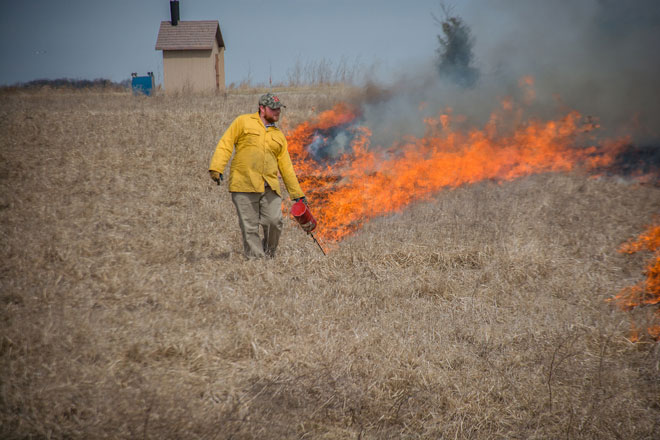Learning about prescribed fire takes the mystery away, teaming up gets the job done
By Jason Andersen
At first glance, maintaining healthy prairie habitat might seem easy: Just plant some native grasses and forbs, walk away, and let nature do its thing.
But prairies don’t work that way. Grasslands especially, but also woodlands and wetlands, need periodic disruption to stay healthy.
“Nature needs fire” is what I tell people when they ask me why prescribed burning is important for habitat. Simply put, fire is good for the land.
Fire prevents trees from taking over grasslands and turning them into forests. Fire also reinvigorates grasses and wildflowers, creating a flush of growth following a burn. Pheasants and quail, along with many other wildlife species, benefit from periodic fire. Burning removes the buildup of dead plant material, allowing chicks to travel under the cover. Birds also benefit from the increased insects and seeds a fire can bring.
 Prescribed burns are purposeful and methodical, often requiring months of planning and preparation beforehand.
Prescribed burns are purposeful and methodical, often requiring months of planning and preparation beforehand.
Fire is an important and natural part of keeping habitat healthy. However, the benefits of fire are only realized when it is used, and this is where you come in.
Using prescribed fire can be intimidating, but people like you can do it. Prescribed burning is the controlled use of fire, under specific conditions, to accomplish ecological benefits.
Prescribed burns are purposeful and methodical, often requiring months of planning and preparation beforehand. These burns are regularly conducted by people just like you, with basic tools, water, and an ignition source. You don’t need a fire truck on site to perform a prescribed burn (although it does help). Performing safe and effective prescribed fire takes knowledge and experience, but it is more accessible than most people think.
You can help your local habitat by learning about prescribed fire and becoming engaged. Throughout the country, prescribed fire is used by state and local governments, conservation groups, and private landowners. Often these groups utilize volunteers to assist them with burns and provide training if needed.
Local Pheasants Forever and Quail Forever chapters, state natural resource agencies, or habitat “friends of” groups may be options in your area. If you are a landowner interested in using fire on your property, Prescribed Burn Associations may be an avenue. These are groups of landowners who share equipment and labor to help each other conduct burns on their lands.
For opportunities specific to your state, you can reach out to a Pheasants Forever and Quail Forever prescribed fire coordinator, or a local biologist. If you are reading this, there is likely an opportunity for you to be involved with prescribed fire and help the habitat in your local area.
Jason Andersen is the Prescribed Burn Coordinator for Pheasants Forever, Inc. and Quail Forever in Minnesota. He works to promote and support the safe and effective use of prescribed fire on private lands across the state.